After the rebadged thing, here is the original.
A little history
Designed during the war, the Renault 4CV became the symbol of the return of peace and prosperity. It also was the first really popular French car, giving access to motorization to the country’s working class which up to then had to content itself with motorcycles and bicycles. As a matter of fact the 4CV became the first French car to be produced in more than a million copies.
In 1940, the German invaders put their hands on virtually all of the French industrial facilities. Renault was a jewel among the booty. Not only was it the second automobile manufacturer in the country after Citroën, it was one of the main trucks producers, and was heavily involved in aeronautics (the company had built aircraft engines since the birth of aviation and had bought airplane manufacturer Caudron during the late Thirties) and armoured vehicles (Renault was a main tank producer since the introduction of the FT17, the first modern tank, back in the Great War). From then on, Renault had no other choice than support the Third Reich’s war effort.
Nonetheless, as soon as 1940 the company’s designing team started to imagine what a postwar Renault would look like. Working in utter secrecy, far from the preying eyes of the Germans, the engineers were able to produce a prototype in December 1942. After miraculously escaping from an Allied air raid which flattened most of the Billancourt factory, the car was able to undertake its first discreet road tests shortly after New Year’s Day, 1943.
A very compact car, the 4CV prototype was a rounded two-door saloon built in aluminium. It was fitted with a rear-mounted four displacing 760 cc and, despite its modest output, the lightweight car can achieve a correct level of performance. Many have noted a strong resemblance with the Volkswagen Beetle which, considering the Renault Juvaquatre-Opel Olympia connection, was probably not a coincidence.
Several prototypes saw light during the long and difficult development of the car, which had to be suspended every time the German officials supervising the factory suspected anything. The main evolution of the 4CV during this period was the addition of two more doors, making it a tiny (3.66 meters long) but practical car. When this last prototype, now very close to the production model, appeared in November 1945, the war was then over. Many changes had taken place at Renault, the new French authorities, eager to grab the huge factories of the manufacturer, having thrown into jail its founder Louis Renault, charged with collaboration with the enemy. The old man had the good taste of dying while behind bars, allowing the government to make its plans come true. Well, he was actually helped by the poor sanitary conditions within the prison and the regular beatings of the wardens. Indeed, the circumstances in which was born what was to become the pride of the French state-owned industry for many decades to come was tantamount to murder.
The 4CV was ready for production in 1946 but, by that time, the company was still rebuilding its widely-destroyed factory, so the launch had to be postponed. Despite being formally introduced during the Paris motor show in October 1946, no 4CV could be produced before August 1947. Nonetheless, it became the first brand-new car thrown to avid French motorists since the end of the conflict, easily beating the Citroën 2CV, still under development despite being on the Javel’s drawing boards since the late Thirties. The head of the newly-formed Régie Nationale des Usines Renault (RNUR), Pierre Lefaucheux, insisting on concentrating all efforts on a single model, the 4CV became the only passenger car produced by the company, another wartime project for a large, American-styled 11CV saloon being abandoned, except for its roomy estate variant that would be introduced as the Colorale.
Despite a tricky handling due to a combination of a heavy tail, a very direct steering and a sensibility to crosswind, the 4CV immediately seduced most people thanks to its low price and the practicality of its four doors. Having not seen a new car in years, the French public didn’t mind either if the very first 4CVs, owing to the take-over by Renault of large stocks of paint abandoned by the German army in retreat, were only available in Afrikakorps sable or Wehrmacht kaki green…
Success immediately greeted the 4CV’s introduction. Some new models were progressively introduced, such as the “découvrable” (convertible saloon) or the “commerciale” (commercial saloon loaded and unloaded through the rear doors, as a hatchback couldn’t be added to the rear-engine car). Another evolution was the replacement of the original R1060 type (760 cc, 17 hp) by the R1062 (747 cc, 21 hp). As you probably noticed the newer version received a smaller engine than its predecessor, a rare occurrence as engines are generally enlarged as time goes by. The reason was that the 4CV’s block had found a huge popularity in motor racing, and the new R1062 engine allowed competing in the 750 cc class, in which the car soon had no worthy competitor. A version specially designed for racing, the R1063, was even created. With 35 hp, the R1063’s road version could reach 120 kph, but a track-prepared R1063 would be good for 140 kph. Still, when Renault decided to enter a large factory team in the 1951 Le Mans 24 Hours, it would take brave men to drive such cars which, rushing through the night at this pace on the Mulsanne straight, could be rammed at any time by Jaguars, Ferraris or Talbots going at almost twice this speed…
By the early Fifties, the 4CV had been improved to such an extent it wouldn’t evolve much for the remainder of its career. A huge success within France, it started attracting interest abroad. Renault’s Spanish branch Fasa launched its automobile production in 1951 with the 4CV. Hino built it under licence in Japan from 1953. Large quantities were exported in the whole of Latin America and, more surprisingly, in North America. Another large export market for the tiny Renault was Australia.
The 4CV was extremely popular as a base for many a little manufacturer constructing small series of special coupes or convertibles. A few among them were Alpine, V.P., Rosier or Autobleu. It was also adopted as a patrol car by the Parisian police. Such cars were soon nicknamed “voitures-pies” because of their paintjob (“pie” means magpie in French, so the expression is quite similar the English “Panda car”). A voiture-pie would receive special doors allowing for quick exit, a two-way radio set and a 30 hp engine.
Though an electromagnetic “Ferlec” clutch, purchased from Ferodo, was available as an option from 1956, and an improved heater introduced two years later solved one of the car’s main problem, the 4CV wouldn’t change much as Renault’s attention now focused on the new Dauphine, a larger rear-engine saloon. The very last 4CV was built as late as in July 1961, when it was succeeded by the ground-breaking hatchback, the Renault 4.
About the models
A big “s” at the end of the word “model”, as there are plenty of them this time!
Model: Renault 4CV R1060
Year: 1947
Maker: Eligor
Scale: 1/43
Distributed by: Hachette as no.1 of its 4CV Renault press series
Acquired: brand new, in December 2008, in Souillac, France
Eligor designed this scale model of the 4CV well enough, though nothing about it is truly extraordinary. Unfortunately the manufacturing’s standard of quality is far from great. I’ll give 11/20 to this model.
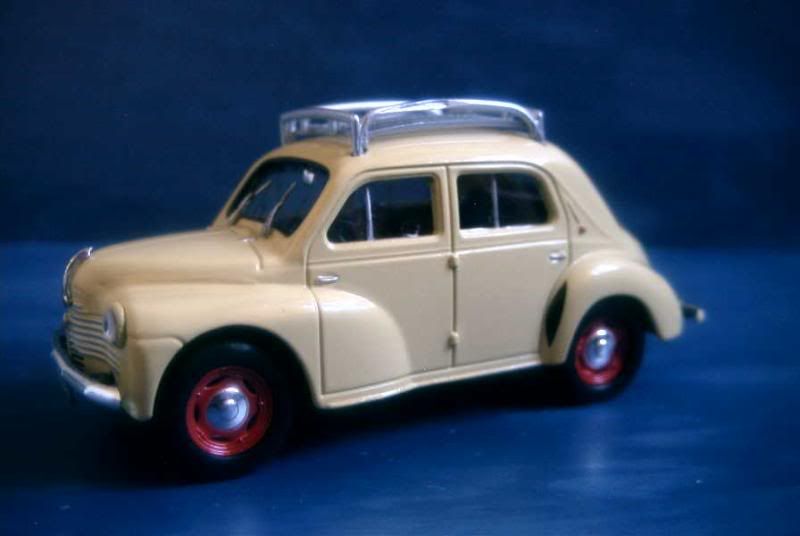
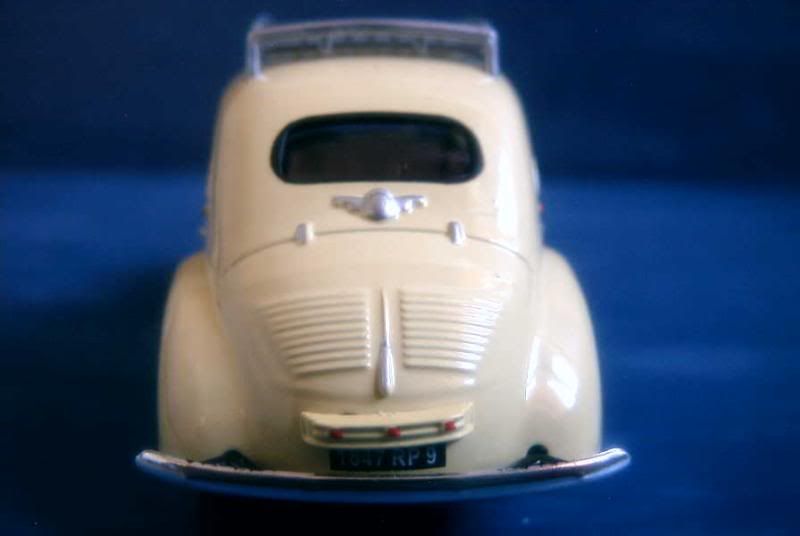
Model: Renault 4CV R1062
Year: 1950
Maker: Ixo
Scale: 1/43
Distributed by: Altaya as no.1 of its Nos Chères Voitures d'Antan press series
Acquired: second hand with stand but without box, in December 2008, in Brive, France
A nice 4CV overall but lacking in details. My remark about the door handles is obviously the same that the one I made about Ixo’s Hino, built with the same mould. Pleasant but probably not worth more than 12/20.

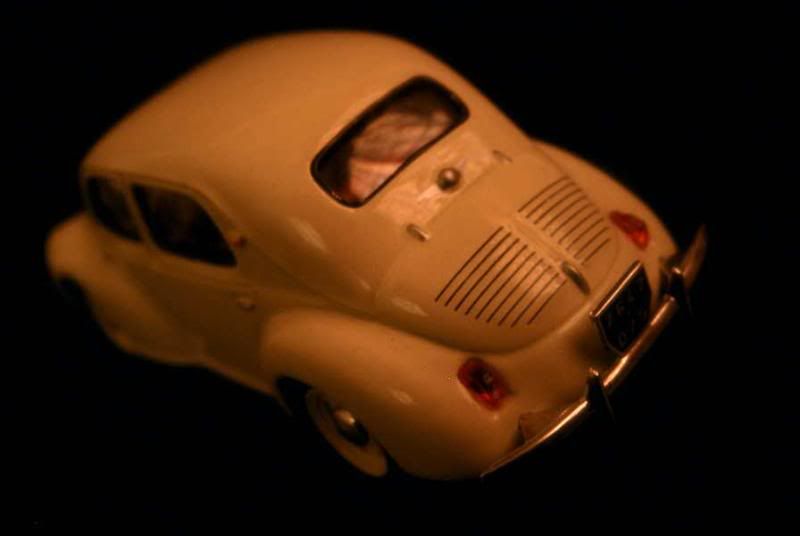
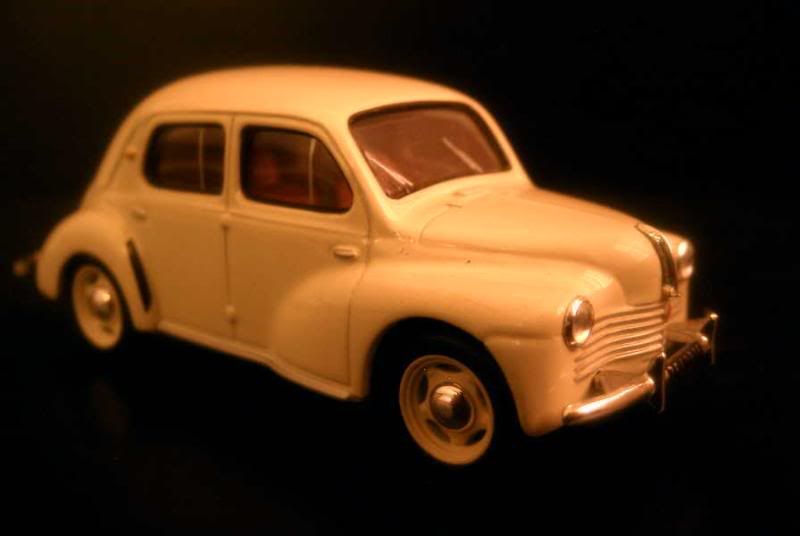
Model: Renault 4CV R1063
Year: 1951
Event: 1951 Le Mans 24 Hours, driven by François Landon and André Briat (finished 24th overall, class winners)
Maker: Ixo
Scale: 1/43
Distributed by: Altaya as no.59 of its Les Plus Belles Voitures des 24 Heures du Mans press series
Acquired: brand new, in May 2006, in Souillac, France
Certainly an original car, though unfortunately Ixo doesn’t reproduce any other Le Mans 4CV than this one. My rating is 12/20.
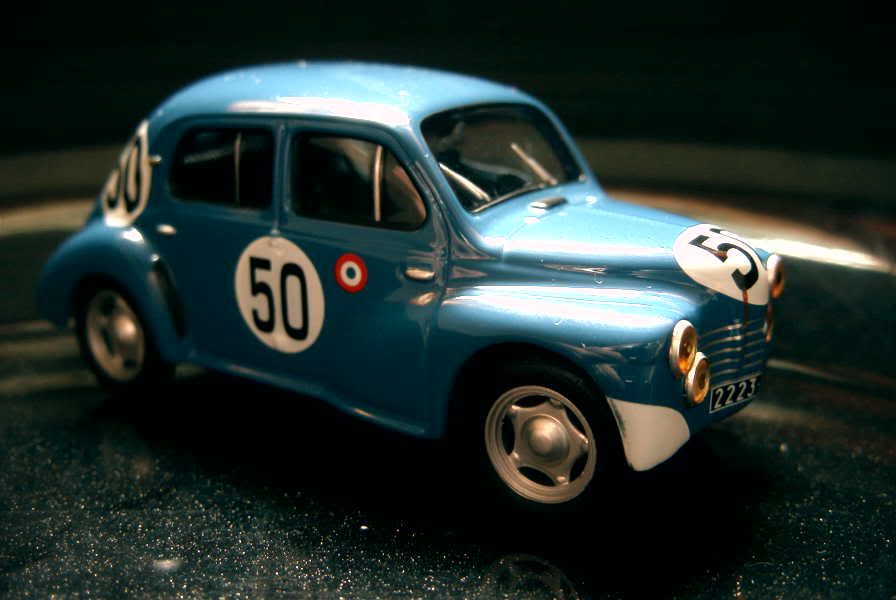

Model: Renault 4CV Commerciale
Year: c.1952
Maker: Eligor
Scale: 1/43
Distributed by: Atlas as no.26 of its Les petits utilitaires des années 50-60 series
Acquired: second hand with neither stand nor box, in October 2007, in Brive, France
It’s basically a poor-quality 4CV with a “BIC” decal glued to it. Fine, there are many collectors of commercial vehicles out there, but are they gullible enough to buy such a model car? (I mean, to buy it new at 22.50 euros - I got mine for 2 euros, and I would have had regrets if I had spent more.) My rating is 7/20.

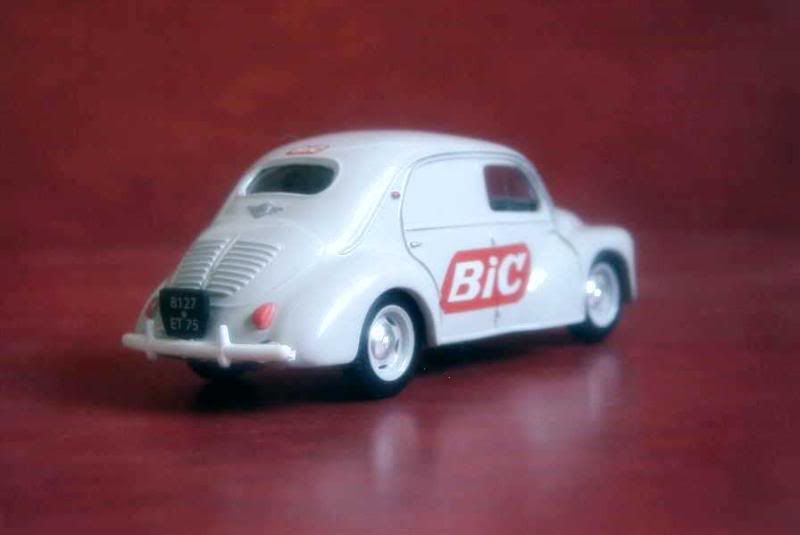
Model: Renault 4CV Découvrable
Year: 1952
Maker: Ixo
Scale: 1/43
Distributed by: Altaya as no.68 of its Nos Chères Voitures d'Antan press series
Acquired: brand new, in December 2006, in Souillac, France
The open roof revealing a pleasant dashboard and the (uncomfortable) seats of the 4CV allows to distract from the flaws of the Ixo reproduction of the little Renault. My rating is this time a good 13/20.
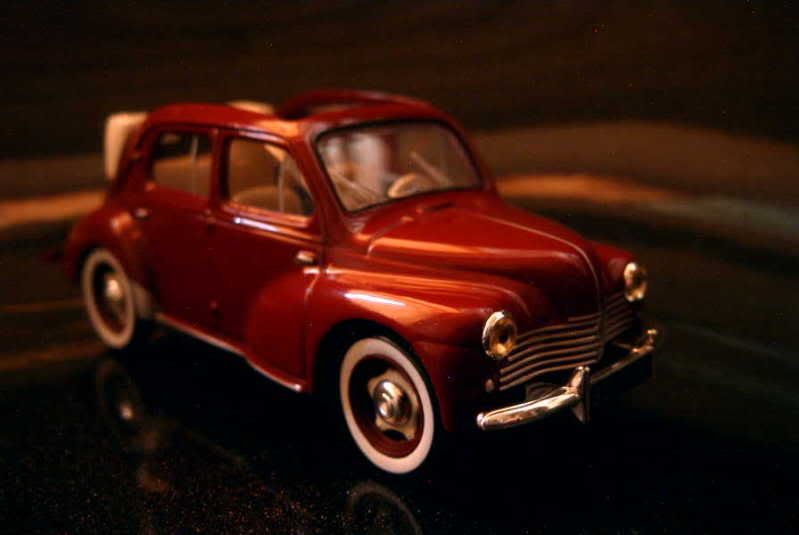
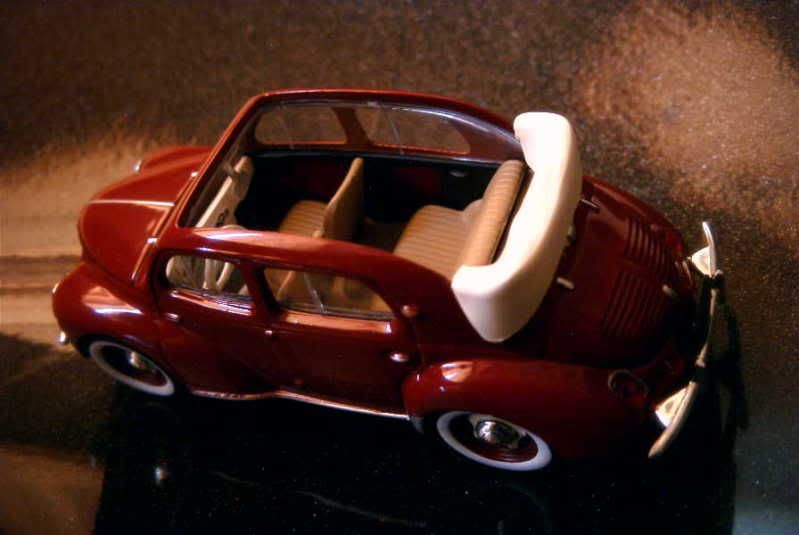
Model: Renault 4CV Commerciale
Year: 1954
Maker: Solido
Scale: 1/43
Distributed by: Solido, “Pompiers” series
Acquired: brand new, in February 2004, in Brive, France
A simple reproduction, Solido-style some would say. It suffers from the very low ground clearance which totally changes the appearance of the car, and the absence of any decal on the registration plates. My rating is 8/20.
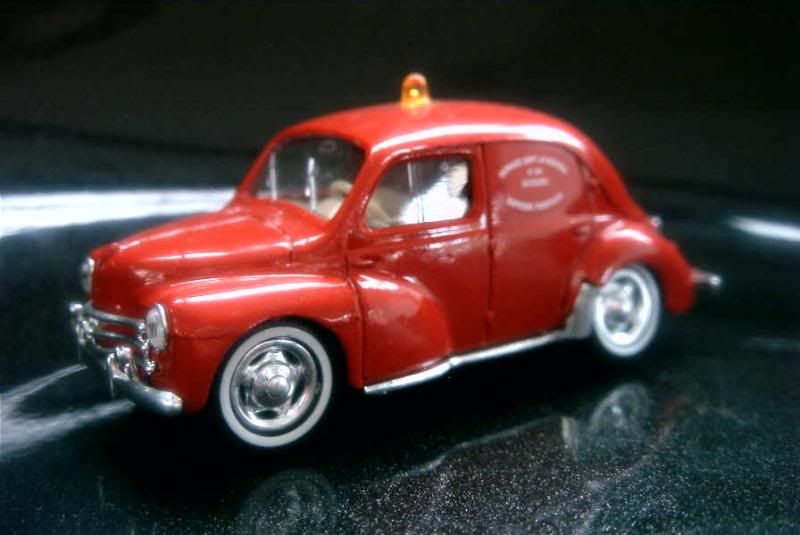
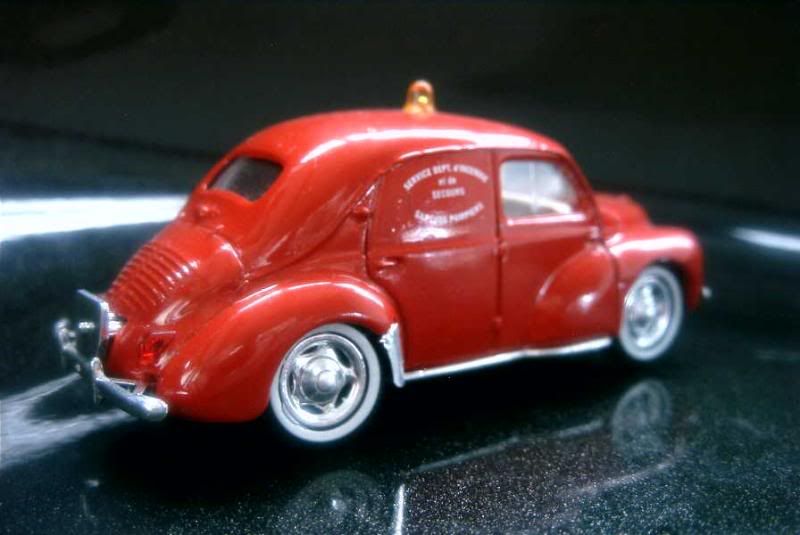
Model: Renault 4CV
Year: 1955
Maker: Ixo
Scale: 1/43
Distributed by: Altaya as no.66 of its Taxis du Monde press series
Acquired: brand new, c.October 2004, in Souillac, France
Ixo reproduced its 4CV as a Tunis taxi, not only changing the decoration but altering its mould to represent the new, simpler front grille introduced in 1954. Sympathetic, though not necessarily indispensible: 12/20.

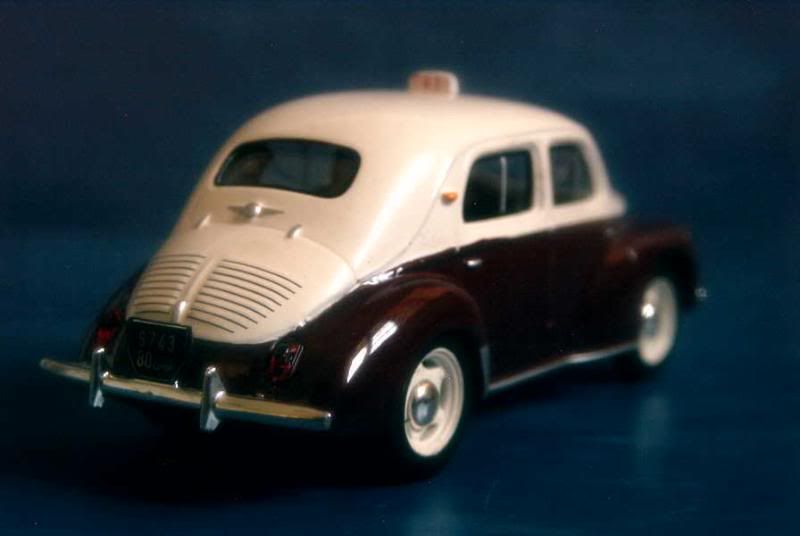
Model: Renault 4CV “Voiture-Pie”
Year: 1956
Maker: Ixo
Scale: 1/43
Distributed by: Altaya as a subscribers’ gift to its Nos Chères Voitures d'Antan press series
Acquired: brand new, in March 2004, through subscription in Souillac, France
A rather pleasing rendition of a Paris voiture-pie. Ixo correctly reproduced the front side windows, which present an overhang over the cut-out doors - a detail I never noticed on pictures of the real car until I got this model - and enlarged the rear window. My rating is 13/20.
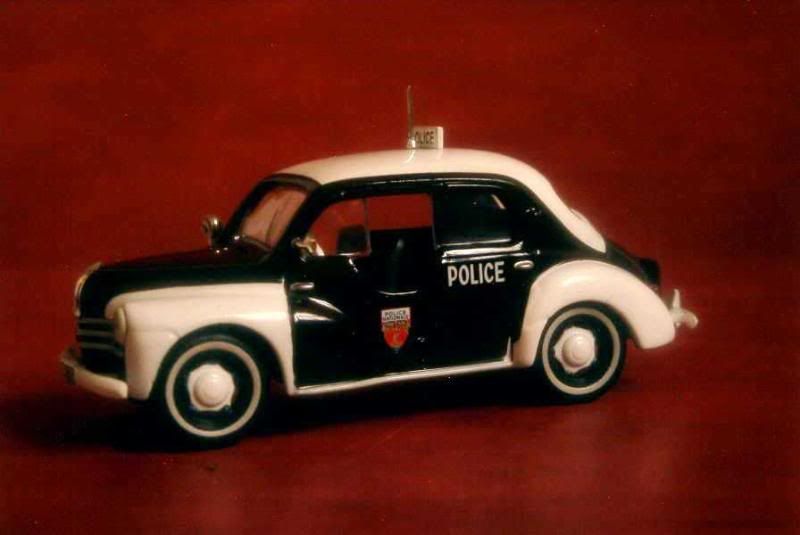
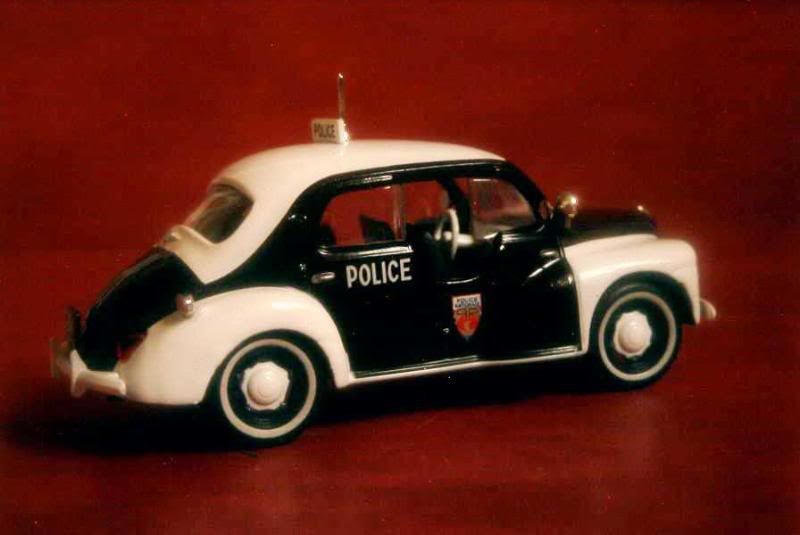
Model: Renault 4CV “Voiture-Pie”
Year: 1956
Maker: Eligor
Scale: 1/43
Distributed by: Atlas as no.3 of its Les petits utilitaires des années 50-60 series
Acquired: second hand with neither stand nor box, in October 2007, in Brive, France
Same car, different reproduction. Eligor’s mould is older and this cannot be hidden. Many omitted details and several mistakes justify a 6/20 rating.
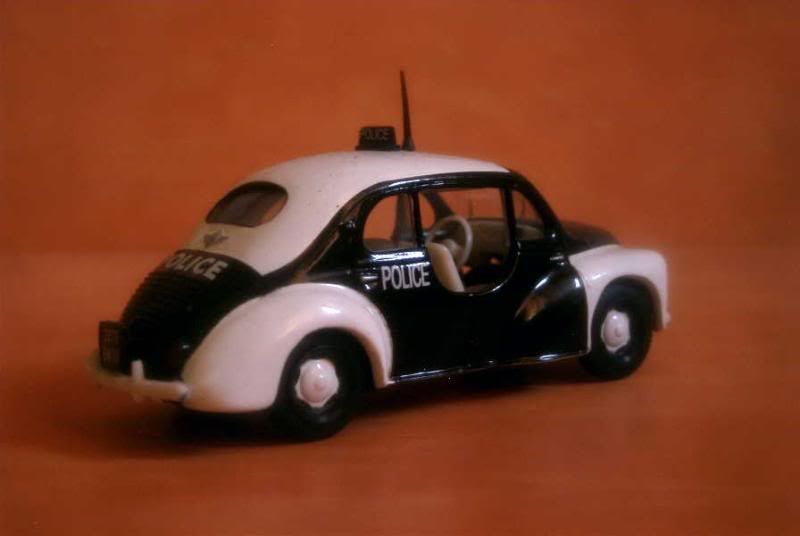
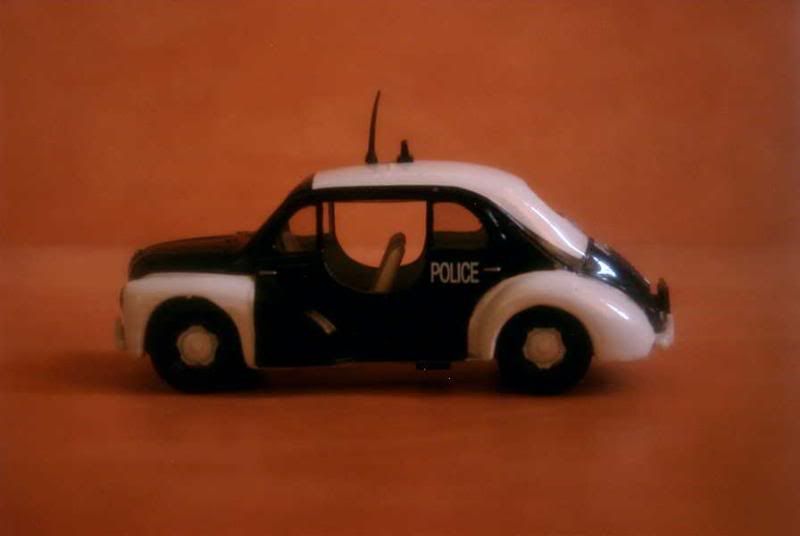
Model: Renault 4CV “Voiture-Pie”
Year: 1956
Maker: Eligor
Scale: 1/43
Distributed by: Hachette as no.2 of its 4CV Renault press series
Acquired: brand new, in January 2008, in Souillac, France
Eligor again, but this time with a brand-new mould. Following the popularity of the voiture-pie among Paris policemen, the tiny principalty of Monaco wanted the same car for its own constabulary. Here is the result, reproduced well enough to deserve a 13/20.

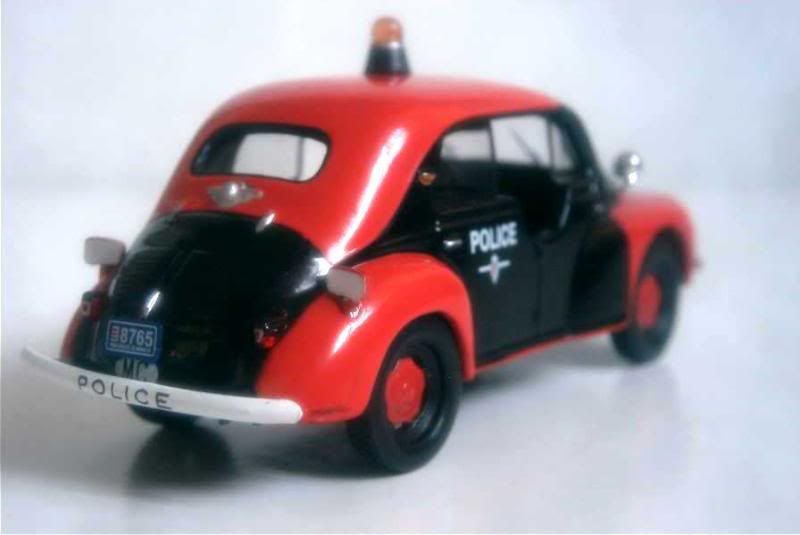
A little history
Designed during the war, the Renault 4CV became the symbol of the return of peace and prosperity. It also was the first really popular French car, giving access to motorization to the country’s working class which up to then had to content itself with motorcycles and bicycles. As a matter of fact the 4CV became the first French car to be produced in more than a million copies.
In 1940, the German invaders put their hands on virtually all of the French industrial facilities. Renault was a jewel among the booty. Not only was it the second automobile manufacturer in the country after Citroën, it was one of the main trucks producers, and was heavily involved in aeronautics (the company had built aircraft engines since the birth of aviation and had bought airplane manufacturer Caudron during the late Thirties) and armoured vehicles (Renault was a main tank producer since the introduction of the FT17, the first modern tank, back in the Great War). From then on, Renault had no other choice than support the Third Reich’s war effort.
Nonetheless, as soon as 1940 the company’s designing team started to imagine what a postwar Renault would look like. Working in utter secrecy, far from the preying eyes of the Germans, the engineers were able to produce a prototype in December 1942. After miraculously escaping from an Allied air raid which flattened most of the Billancourt factory, the car was able to undertake its first discreet road tests shortly after New Year’s Day, 1943.
A very compact car, the 4CV prototype was a rounded two-door saloon built in aluminium. It was fitted with a rear-mounted four displacing 760 cc and, despite its modest output, the lightweight car can achieve a correct level of performance. Many have noted a strong resemblance with the Volkswagen Beetle which, considering the Renault Juvaquatre-Opel Olympia connection, was probably not a coincidence.
Several prototypes saw light during the long and difficult development of the car, which had to be suspended every time the German officials supervising the factory suspected anything. The main evolution of the 4CV during this period was the addition of two more doors, making it a tiny (3.66 meters long) but practical car. When this last prototype, now very close to the production model, appeared in November 1945, the war was then over. Many changes had taken place at Renault, the new French authorities, eager to grab the huge factories of the manufacturer, having thrown into jail its founder Louis Renault, charged with collaboration with the enemy. The old man had the good taste of dying while behind bars, allowing the government to make its plans come true. Well, he was actually helped by the poor sanitary conditions within the prison and the regular beatings of the wardens. Indeed, the circumstances in which was born what was to become the pride of the French state-owned industry for many decades to come was tantamount to murder.
The 4CV was ready for production in 1946 but, by that time, the company was still rebuilding its widely-destroyed factory, so the launch had to be postponed. Despite being formally introduced during the Paris motor show in October 1946, no 4CV could be produced before August 1947. Nonetheless, it became the first brand-new car thrown to avid French motorists since the end of the conflict, easily beating the Citroën 2CV, still under development despite being on the Javel’s drawing boards since the late Thirties. The head of the newly-formed Régie Nationale des Usines Renault (RNUR), Pierre Lefaucheux, insisting on concentrating all efforts on a single model, the 4CV became the only passenger car produced by the company, another wartime project for a large, American-styled 11CV saloon being abandoned, except for its roomy estate variant that would be introduced as the Colorale.
Despite a tricky handling due to a combination of a heavy tail, a very direct steering and a sensibility to crosswind, the 4CV immediately seduced most people thanks to its low price and the practicality of its four doors. Having not seen a new car in years, the French public didn’t mind either if the very first 4CVs, owing to the take-over by Renault of large stocks of paint abandoned by the German army in retreat, were only available in Afrikakorps sable or Wehrmacht kaki green…
Success immediately greeted the 4CV’s introduction. Some new models were progressively introduced, such as the “découvrable” (convertible saloon) or the “commerciale” (commercial saloon loaded and unloaded through the rear doors, as a hatchback couldn’t be added to the rear-engine car). Another evolution was the replacement of the original R1060 type (760 cc, 17 hp) by the R1062 (747 cc, 21 hp). As you probably noticed the newer version received a smaller engine than its predecessor, a rare occurrence as engines are generally enlarged as time goes by. The reason was that the 4CV’s block had found a huge popularity in motor racing, and the new R1062 engine allowed competing in the 750 cc class, in which the car soon had no worthy competitor. A version specially designed for racing, the R1063, was even created. With 35 hp, the R1063’s road version could reach 120 kph, but a track-prepared R1063 would be good for 140 kph. Still, when Renault decided to enter a large factory team in the 1951 Le Mans 24 Hours, it would take brave men to drive such cars which, rushing through the night at this pace on the Mulsanne straight, could be rammed at any time by Jaguars, Ferraris or Talbots going at almost twice this speed…
By the early Fifties, the 4CV had been improved to such an extent it wouldn’t evolve much for the remainder of its career. A huge success within France, it started attracting interest abroad. Renault’s Spanish branch Fasa launched its automobile production in 1951 with the 4CV. Hino built it under licence in Japan from 1953. Large quantities were exported in the whole of Latin America and, more surprisingly, in North America. Another large export market for the tiny Renault was Australia.
The 4CV was extremely popular as a base for many a little manufacturer constructing small series of special coupes or convertibles. A few among them were Alpine, V.P., Rosier or Autobleu. It was also adopted as a patrol car by the Parisian police. Such cars were soon nicknamed “voitures-pies” because of their paintjob (“pie” means magpie in French, so the expression is quite similar the English “Panda car”). A voiture-pie would receive special doors allowing for quick exit, a two-way radio set and a 30 hp engine.
Though an electromagnetic “Ferlec” clutch, purchased from Ferodo, was available as an option from 1956, and an improved heater introduced two years later solved one of the car’s main problem, the 4CV wouldn’t change much as Renault’s attention now focused on the new Dauphine, a larger rear-engine saloon. The very last 4CV was built as late as in July 1961, when it was succeeded by the ground-breaking hatchback, the Renault 4.
About the models
A big “s” at the end of the word “model”, as there are plenty of them this time!
Model: Renault 4CV R1060
Year: 1947
Maker: Eligor
Scale: 1/43
Distributed by: Hachette as no.1 of its 4CV Renault press series
Acquired: brand new, in December 2008, in Souillac, France
Eligor designed this scale model of the 4CV well enough, though nothing about it is truly extraordinary. Unfortunately the manufacturing’s standard of quality is far from great. I’ll give 11/20 to this model.


Model: Renault 4CV R1062
Year: 1950
Maker: Ixo
Scale: 1/43
Distributed by: Altaya as no.1 of its Nos Chères Voitures d'Antan press series
Acquired: second hand with stand but without box, in December 2008, in Brive, France
A nice 4CV overall but lacking in details. My remark about the door handles is obviously the same that the one I made about Ixo’s Hino, built with the same mould. Pleasant but probably not worth more than 12/20.



Model: Renault 4CV R1063
Year: 1951
Event: 1951 Le Mans 24 Hours, driven by François Landon and André Briat (finished 24th overall, class winners)
Maker: Ixo
Scale: 1/43
Distributed by: Altaya as no.59 of its Les Plus Belles Voitures des 24 Heures du Mans press series
Acquired: brand new, in May 2006, in Souillac, France
Certainly an original car, though unfortunately Ixo doesn’t reproduce any other Le Mans 4CV than this one. My rating is 12/20.


Model: Renault 4CV Commerciale
Year: c.1952
Maker: Eligor
Scale: 1/43
Distributed by: Atlas as no.26 of its Les petits utilitaires des années 50-60 series
Acquired: second hand with neither stand nor box, in October 2007, in Brive, France
It’s basically a poor-quality 4CV with a “BIC” decal glued to it. Fine, there are many collectors of commercial vehicles out there, but are they gullible enough to buy such a model car? (I mean, to buy it new at 22.50 euros - I got mine for 2 euros, and I would have had regrets if I had spent more.) My rating is 7/20.


Model: Renault 4CV Découvrable
Year: 1952
Maker: Ixo
Scale: 1/43
Distributed by: Altaya as no.68 of its Nos Chères Voitures d'Antan press series
Acquired: brand new, in December 2006, in Souillac, France
The open roof revealing a pleasant dashboard and the (uncomfortable) seats of the 4CV allows to distract from the flaws of the Ixo reproduction of the little Renault. My rating is this time a good 13/20.


Model: Renault 4CV Commerciale
Year: 1954
Maker: Solido
Scale: 1/43
Distributed by: Solido, “Pompiers” series
Acquired: brand new, in February 2004, in Brive, France
A simple reproduction, Solido-style some would say. It suffers from the very low ground clearance which totally changes the appearance of the car, and the absence of any decal on the registration plates. My rating is 8/20.


Model: Renault 4CV
Year: 1955
Maker: Ixo
Scale: 1/43
Distributed by: Altaya as no.66 of its Taxis du Monde press series
Acquired: brand new, c.October 2004, in Souillac, France
Ixo reproduced its 4CV as a Tunis taxi, not only changing the decoration but altering its mould to represent the new, simpler front grille introduced in 1954. Sympathetic, though not necessarily indispensible: 12/20.


Model: Renault 4CV “Voiture-Pie”
Year: 1956
Maker: Ixo
Scale: 1/43
Distributed by: Altaya as a subscribers’ gift to its Nos Chères Voitures d'Antan press series
Acquired: brand new, in March 2004, through subscription in Souillac, France
A rather pleasing rendition of a Paris voiture-pie. Ixo correctly reproduced the front side windows, which present an overhang over the cut-out doors - a detail I never noticed on pictures of the real car until I got this model - and enlarged the rear window. My rating is 13/20.


Model: Renault 4CV “Voiture-Pie”
Year: 1956
Maker: Eligor
Scale: 1/43
Distributed by: Atlas as no.3 of its Les petits utilitaires des années 50-60 series
Acquired: second hand with neither stand nor box, in October 2007, in Brive, France
Same car, different reproduction. Eligor’s mould is older and this cannot be hidden. Many omitted details and several mistakes justify a 6/20 rating.


Model: Renault 4CV “Voiture-Pie”
Year: 1956
Maker: Eligor
Scale: 1/43
Distributed by: Hachette as no.2 of its 4CV Renault press series
Acquired: brand new, in January 2008, in Souillac, France
Eligor again, but this time with a brand-new mould. Following the popularity of the voiture-pie among Paris policemen, the tiny principalty of Monaco wanted the same car for its own constabulary. Here is the result, reproduced well enough to deserve a 13/20.





4 comments:
Great models specialy the one from Le Mans. My collection is made of a lot of Models Models but I don´t have that one.
This one's probably less popular among Le Mans collectors than a Ferrari GTO or a Jaguar D-Type, I wonder why... Thanks for your appreciation RM Style! :)
Great casting..so cute..
Now that you said what your tastes regarding automobiles are, I'm not much surprised that you like this one! Thanks for exploring old posts!
Post a Comment